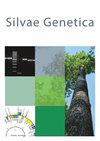利用可见近红外光谱检测柞树橡子虫害的准确性评估
IF 1
4区 农林科学
Q3 FORESTRY
引用次数: 0
摘要
本研究旨在测试近红外光谱法,以评估从韩国济州岛栎树种子园采集的栎树橡子受到的虫害。共对 550 颗橡子进行了分类,分为 362 颗健全橡子和 178 颗不健全(虫害)橡子,然后进行了近红外光谱分析。为尽量减少光谱数据误差,采用了一阶导数、乘法散度校正、标准正态变量和萨维茨基-戈莱滤波器等预处理技术,以及偏最小二乘法等多元分析方法。然后,利用投影中的变量重要性评估了模型的性能,包括准确度和精确度。橡子的近红外波长在 660~720nm 处有较强的吸收峰,在 900~1000nm 处有轻微的下降趋势。在 400~1000nm 波长范围内,采用萨维茨基-戈莱滤波处理和偏最小二乘法是区分不健全橡子的最有效模型,预测准确率为 86 %(p<0.05)。660~720nm 和 960~1000nm 波长范围内的吸收点对预测结果有明显影响,后一波长范围内的吸收点被认为受到虫害导致的水分和碳水化合物变化的影响。前一波长范围由于叶绿素和颜色的变化而显示出较低的分类能力,但与近红外波长范围一起使用时会影响模型的性能。这些发现可以为今后使用更宽波长范围或多光谱分析的研究缩小调查范围。本文章由计算机程序翻译,如有差异,请以英文原文为准。
Accuracy Evaluation of Visible-Near Infrared Spectroscopy for Detecting Insect Damage in Acorns of Quercus acuta
This study aimed to test near-infrared spectroscopy to assess insect damage to oak acorns collected from a seed orchard of Quercus acuta in Jeju Island, Korea. A total of 550 acorns were sorted into 362 sound and 178 unsound (insect-damaged) acorns, followed by near-infrared spectroscopy. To minimize spectral data errors, preprocessing techniques such as first derivative, multiplicative scatter correction, standard normal variate, and Savitzky-Golay filter were applied, along with multivariate analysis methods like partial least squares. Then the model performance, including accuracy and precision, was evaluated using the Variable Importance in Projection. The near-infrared wavelength of the acorns showed strong absorption peaks at 660~720nm and a slight downward trend at 900~1000nm. The most effective model for distinguishing unsound acorns was Savitzky-Golay filtering treatment applied in the 400~1000nm range and used partial least squares, showing prediction accuracy of 86 % (p<0.05). The performance was significantly influenced by absorption points at 660~720nm and 960~1000nm, with the latter range believed to be affected by changes in moisture and carbohydrates due to insect damage. The former range showed lower classification capability due to chlorophyll and color variation but affected the model performance when used with near-infrared wavelength range. These findings can narrow down the scope of investigation for future research using wider wavelength ranges or multispectral analysis.
求助全文
通过发布文献求助,成功后即可免费获取论文全文。
去求助
来源期刊

Silvae Genetica
农林科学-林学
CiteScore
2.20
自引率
10.00%
发文量
10
审稿时长
3 months
期刊介绍:
Silvae Genetica is an international peer reviewed journal with more than 65 year tradition and experience in all fields of theoretical and applied Forest Genetics and Tree breeding. It continues "Zeitschrift für Forstgenetik und Forstpflanzenzüchtung" (Journal of Forest Genetics and Forest Tree Breeding) founded by W. LANGNER in 1951.
 求助内容:
求助内容: 应助结果提醒方式:
应助结果提醒方式:


